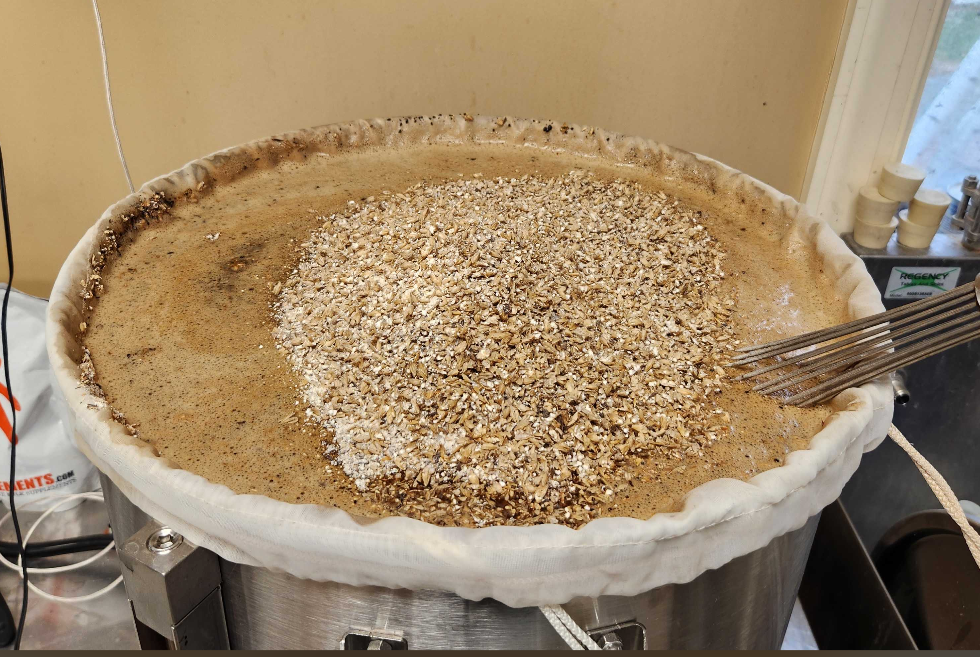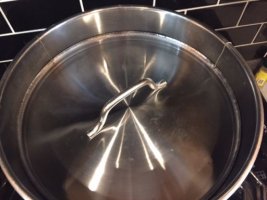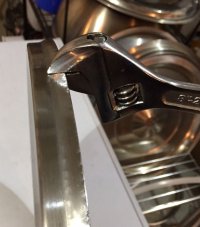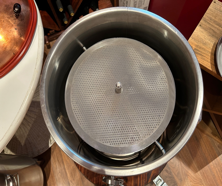The theory is that a mash cap needs to float to keep the surface from having contact with oxygen.
You are using an out of date browser. It may not display this or other websites correctly.
You should upgrade or use an alternative browser.
You should upgrade or use an alternative browser.
Mash Caps... Let me see what you got!
- Thread starter DonT
- Start date

Help Support Homebrew Talk:
This site may earn a commission from merchant affiliate
links, including eBay, Amazon, and others.
It doesn't necessarily need to float, it just needs to seal out the air as much as possible.The theory is that a mash cap needs to float to keep the surface from having contact with oxygen.
Needless to say, I fretted over that too. Its a foamed polypropylene material and the material is food safe.Martin is that material food grade though? Would be my only concern about it
Ahhh good to know!Needless to say, I fretted over that too. Its a foamed polypropylene material and the material is food safe.
My balls are polypropylene and also food safe! (that didn't come out right
Oxygen is a pesky adversary. It needs to float because that means zero "air gap" between the mash cap and the surface of your wort. Sealing out air also means some got sealed in! Yes, it needs to float to be useful for oxygen mitigation.It doesn't necessarily need to float, it just needs to seal out the air as much as possible.
skunkape
Pull my finger…
OK. Time for today's DFQ...
Why the heck would I need to protect a mash from oxygen exposure when I'm oxygenating wort before the pitch anyhow? Somebody point me to the science here.
Why the heck would I need to protect a mash from oxygen exposure when I'm oxygenating wort before the pitch anyhow? Somebody point me to the science here.

$44.99
$49.95
Craft A Brew - Mead Making Kit – Reusable Make Your Own Mead Kit – Yields 1 Gallon of Mead
Craft a Brew

$20.94
$29.99
The Brew Your Own Big Book of Clone Recipes: Featuring 300 Homebrew Recipes from Your Favorite Breweries
Amazon.com

$159.99 ($26.66 / Count)
3M High Flow Series System BREW120-MS, 5616001, For Brewed Coffee and Hot Tea, Valve-in-Head Design
SpaceCityProviders

$58.16
HUIZHUGS Brewing Equipment Keg Ball Lock Faucet 30cm Reinforced Silicone Hose Secondary Fermentation Homebrew Kegging Brewing Equipment
xiangshuizhenzhanglingfengshop

$53.24
1pc Hose Barb/MFL 1.5" Tri Clamp to Ball Lock Post Liquid Gas Homebrew Kegging Fermentation Parts Brewer Hardware SUS304(Liquid Hose Barb)
yunchengshiyanhuqucuichendianzishangwuyouxiangongsi

$53.24
1pc Hose Barb/MFL 1.5" Tri Clamp to Ball Lock Post Liquid Gas Homebrew Kegging Fermentation Parts Brewer Hardware SUS304(Gas Hose Barb)
Guangshui Weilu You Trading Co., Ltd

$33.99 ($17.00 / Count)
$41.99 ($21.00 / Count)
2 Pack 1 Gallon Large Fermentation Jars with 3 Airlocks and 2 SCREW Lids(100% Airtight Heavy Duty Lid w Silicone) - Wide Mouth Glass Jars w Scale Mark - Pickle Jars for Sauerkraut, Sourdough Starter
Qianfenie Direct

$7.79 ($7.79 / Count)
Craft A Brew - LalBrew Voss™ - Kveik Ale Yeast - For Craft Lagers - Ingredients for Home Brewing - Beer Making Supplies - (1 Pack)
Craft a Brew

$10.99 ($31.16 / Ounce)
Hornindal Kveik Yeast for Homebrewing - Mead, Cider, Wine, Beer - 10g Packet - Saccharomyces Cerevisiae - Sold by Shadowhive.com
Shadowhive

$479.00
$559.00
EdgeStar KC1000SS Craft Brew Kegerator for 1/6 Barrel and Cornelius Kegs
Amazon.com

$76.92 ($2,179.04 / Ounce)
Brewing accessories 1.5" Tri Clamp to Ball Lock Post Liquid Gas Homebrew Kegging Fermentation Parts Brewer Hardware SUS304 Brewing accessories(Gas Hose Barb)
chuhanhandianzishangwu

$22.00 ($623.23 / Ounce)
AMZLMPKNTW Ball Lock Sample Faucet 30cm Reinforced Silicone Hose Secondary Fermentation Homebrew Kegging joyful
无为中南商贸有限公司

$176.97
1pc Commercial Keg Manifold 2" Tri Clamp,Ball Lock Tapping Head,Pressure Gauge/Adjustable PRV for Kegging,Fermentation Control
hanhanbaihuoxiaoshoudian

$28.98
Five Star - 6022b_ - Star San - 32 Ounce - High Foaming Sanitizer
Great Fermentations of Indiana

$172.35
2 Inch Tri Clamp Keg Manifold With Ball Lock Posts, Pressure Gauge, PRV (0-30 PSI) – Homebrew, Fermentation, Kegging System
wuhanshijiayangzhiyimaoyiyouxiangongsi

$719.00
$799.00
EdgeStar KC2000TWIN Full Size Dual Tap Kegerator & Draft Beer Dispenser - Black
Amazon.com
Oxidation staling reactions happen much quicker at higher temperatures (with the exception of boiling since O2 does not disolved in boiling water).OK. Time for today's DFQ...
Why the heck would I need to protect a mash from oxygen exposure when I'm oxygenating wort before the pitch anyhow? Somebody point me to the science here.
Active yeast scavenges oxygen and staling reactions occur much slower at pitching temperatures
If you oxygenate with active yeast in the wort, the yeast will scavenge oxygen more quickly than the oxygen can cause damage / staling. However, it's important that your yeast is active, so generally you would always want to pitch yeast from a starter for LoDo methods.
If you pitch directly from a packet the lag time might be too long and negate all the other steps you took on the hotside
There are other threads where low oxygen is debated and rocks can be thrown.
skunkape
Pull my finger…
No rocks here. I just never heard of limiting air exposure anywhere on the hot side and wanted to know what I was missing. Any process that potentially results in better beer is something I want to be aware of. I was a shameless secondary guy for a decade or so. That was just the way you brewed then. I eventually experimented with skipping secondary and closed transfers once I knew that was a thing. Definitely notice the difference with hoppy styles. Not so much on Belgians and Brits tho, which are my favorites. May not change a thing - but sometimes a man agotta do what a manna gotta do. Knowledge being power and all that.There are other threads where low oxygen is debated and rocks can be thrown.
Last edited:
I and others are more than happy to lend knowledge and process' but we have to know it is safe to go in the water so to speak. Low oxygen brewing has had a rough go of it with many people downright rude over the concept. The science is there, it is just not easy to implement on the homebrew scale. The term alone sparks outrage with some homebrewers - "oxygen police" and whatnot. I (we) could care less how other people brew, just don't question something without doing the real world testing and research before one poo poo's it is our stance.
That said, in a nutshell. from the minute one grinds grain, just like when cutting an apple, oxygen starts to interact with compounds that alter the flavors. It is in the interest of a low oxygen brewer to try to limit this interaction as much as possible all the way until you pitch the yeast, which is when you add oxygen. It is a noticeable difference, especially in lagers and Belgian beers. If you want to learn more, just ask.
That said, in a nutshell. from the minute one grinds grain, just like when cutting an apple, oxygen starts to interact with compounds that alter the flavors. It is in the interest of a low oxygen brewer to try to limit this interaction as much as possible all the way until you pitch the yeast, which is when you add oxygen. It is a noticeable difference, especially in lagers and Belgian beers. If you want to learn more, just ask.
Last edited:
skunkape
Pull my finger…
I respect your skills. I'm not here for proving or disproving anything to anybody. I'm just a homebrewer, not an expert and hopefully not a d-bag.
TBH, I'm here mostly for recipes and memes.
TBH, I'm here mostly for recipes and memes.
Cool. Low oxygen is not for everybody and is not essential for all brewers. It creates very clean beers without oxidation as a large flavor component. That might take away some perceived flavors in normal homebrew. But it also clears the way for other flavors to shine.
nevermind... me being dumbI respect your skills. I'm not here for proving or disproving anything to anybody. I'm just a homebrewer, not an expert and hopefully not a d-bag.
TBH, I'm here mostly for recipes and memes.
Last edited:
Didn't need a mashcap on this one.


It doesn't need to float necessarily, it just needs to seal out air.@DonT any update on if yours floats or not? I'm looking at a similar set up. Thanks.
The lid I posted... I added the seal Bobby linked to and now it's a bit too tight to slide easily onto the pot. So I'm doing something slightly different. I found a place that would cut a circle of SS to a particular diameter, so with some careful measuring, I ordered it and it's coming Friday. I'm going to mount that wiper seal and it should side into the pot nicely. This piece is flat as opposed to the lid that is concave, which could trap air. My solution to that would be to drill a hole near the top of the curve and use a plug to let the air out. I'll probably do that anyway just to give me an easy way to take gravity samples. I'll post new pics when I get it all together.
DuncB
Well-Known Member
If you turn the lid over it won't have this issue.
"This piece is flat as opposed to the lid that is concave, which could trap air"
"This piece is flat as opposed to the lid that is concave, which could trap air"
Bilsch
Well-Known Member
- Joined
- May 4, 2015
- Messages
- 1,754
- Reaction score
- 1,609
Mashcaps really do need to float freely with full contact to the surface of the liquid and not drag along the vessel wall. Doing what you describe is not helping reduce oxygen exposure in the least. You are not only sealing out air but also sealing it in. The result is a wash. Also consider the oxygen contained in only a couple cubic inches of air is quite enough to oxidize the entire mash.It doesn't need to float necessarily, it just needs to seal out air.
The lid I posted... I added the seal Bobby linked to and now it's a bit too tight to slide easily onto the pot. So I'm doing something slightly different. I found a place that would cut a circle of SS to a particular diameter, so with some careful measuring, I ordered it and it's coming Friday. I'm going to mount that wiper seal and it should side into the pot nicely. This piece is flat as opposed to the lid that is concave, which could trap air. My solution to that would be to drill a hole near the top of the curve and use a plug to let the air out. I'll probably do that anyway just to give me an easy way to take gravity samples. I'll post new pics when I get it all together.
I always use a lid on my mash, but I always did it for temperature control. Who knew?
Show me what you came up with....Mashcaps really do need to float freely with full contact to the surface of the liquid and not drag along the vessel wall. Doing what you describe is not helping reduce oxygen exposure in the least. You are not only sealing out air but also sealing it in. The result is a wash. Also consider the oxygen contained in only a couple cubic inches of air is quite enough to oxidize the entire mash.
Don, just take the lid you have and bend up the lip so you create a wall to allow it to float. It does have to float otherwise it is either under water so to speak or there will be air underneath if it is too high. Floating allows the cap to always be in contact with the surface.
I'm abandoning the lid.
I sourced a flat disc of the appropriate diameter so as long as you push it down on to the wort and have a way for the air to escape, it doesn't technically need to float.
I sourced a flat disc of the appropriate diameter so as long as you push it down on to the wort and have a way for the air to escape, it doesn't technically need to float.
I thought I’d run some numbers on this statement:Also consider the oxygen contained in only a couple cubic inches of air is quite enough to oxidize the entire mash.
- 100 mL is about 6 cubic inches.
- 100 mL is roughly 5 millimoles of gas at ambient temperature and pressure, so for air, one millimole of oxygen.
- Assume every oxygen molecule in that headspace goes into solution over the course of the mash, and reacts to form an off-flavor compound, X.
- Assume X is a small molecule with a molar mass of ~100 g. This means there is 100 mg of X created by oxidation.
- For a 20 L batch, that’s 5 mg of X per liter, or 5 ppm.
Also, in my judgment,(3) is likely a very poor assumption. Not every oxygen molecule will make a molecule of X, as there will be other things in the mash to react with. (An alternate way to say it is that collectively, all of the oxidation products must have a weighted average taste threshold of 5 ppm.)
It is very complex. Those of use chasing it are still learning and trying things. The bottom line is that a small amount of O2 has an effect. Not just flavor but color, staling and shelf stability etc... Trapped air is pretty much finite but open air is constantly being replenished. So it is tough to quantify.
But there are limits on the other side too. Too little to zero oxygen has its own character as a lot of flavor components are related to oxidation or what is often referred to as micro oxidation. A tiny amount (scientific term) is needed for flavor. But this is all relative. Large breweries have a lot more liquid compared to surface area (square-cube law). So their brewhouses are more forgiving from an oxygen uptake point of view. Our homebrew systems are way more of a challenge with so much surface area compared to liquid. This is why so much flak has been given to the low oxygen crowd. One has to be over the top to reach the very low threshold. Under 2 ppm for the entire brew day (milling to pitching) would be a goal. Once it can be controlled then one can add or subtract to taste. Say go low for a pils and maybe a little higher for a Scottish ale etc...
It is a given in large breweries just like hydrostatic pressure in big CCVs. That 'large brewery taste' is because of these two things being inherent in their brewing setups. If one wants to emulate that output then limit the O2 and crank up the pressure on your fermenter and that is the best we can do as homebrewers.
But there are limits on the other side too. Too little to zero oxygen has its own character as a lot of flavor components are related to oxidation or what is often referred to as micro oxidation. A tiny amount (scientific term) is needed for flavor. But this is all relative. Large breweries have a lot more liquid compared to surface area (square-cube law). So their brewhouses are more forgiving from an oxygen uptake point of view. Our homebrew systems are way more of a challenge with so much surface area compared to liquid. This is why so much flak has been given to the low oxygen crowd. One has to be over the top to reach the very low threshold. Under 2 ppm for the entire brew day (milling to pitching) would be a goal. Once it can be controlled then one can add or subtract to taste. Say go low for a pils and maybe a little higher for a Scottish ale etc...
It is a given in large breweries just like hydrostatic pressure in big CCVs. That 'large brewery taste' is because of these two things being inherent in their brewing setups. If one wants to emulate that output then limit the O2 and crank up the pressure on your fermenter and that is the best we can do as homebrewers.
The purpose of a mash cap is to reduce the liquid and mash surface area that is exposed to the ambient atmosphere. Having a sealed dead space above the mash isn't the same since there is a quantity of oxygen in that trapped air...unless you completely flushed that volume with an inert gas. That quantity of oxygen would have the opportunity to diffuse into the wort and oxidize it.
Placing an impervious barrier on the surface of the mash is a better method.
Placing an impervious barrier on the surface of the mash is a better method.
Which is what I've been talking about the whole time....Placing an impervious barrier on the surface of the mash is a better method.
Bilsch
Well-Known Member
- Joined
- May 4, 2015
- Messages
- 1,754
- Reaction score
- 1,609
I have the same brand cap as you show in your pictures. I have reworked the lip so that it makes it taller and more buoyant. Just works out with my kettle to have about ~1/16" all the way round so the cap wont drag and can easily follow the volume fluctuations due to temperature change, adding removing water etc.Show me what you came up with....


Last edited:
Bilsch
Well-Known Member
- Joined
- May 4, 2015
- Messages
- 1,754
- Reaction score
- 1,609
On the cold side larger breweries are concerned with parts per billion of oxygen during handling after fermentation and package filling. Same malt flavor compounds being oxidized.I thought I’d run some numbers on this statement:
This is interesting to me because 5 ppm implies a bit about the identity of X. There are plenty of compounds that have far lower flavor thresholds (e.g., MBT, geosmin, 4VG), but there are also plenty that don’t (e.g., acetaldehyde, ethyl acetate.)
- 100 mL is about 6 cubic inches.
- 100 mL is roughly 5 millimoles of gas at ambient temperature and pressure, so for air, one millimole of oxygen.
- Assume every oxygen molecule in that headspace goes into solution over the course of the mash, and reacts to form an off-flavor compound, X.
- Assume X is a small molecule with a molar mass of ~100 g. This means there is 100 mg of X created by oxidation.
- For a 20 L batch, that’s 5 mg of X per liter, or 5 ppm.
Also, in my judgment,(3) is likely a very poor assumption. Not every oxygen molecule will make a molecule of X, as there will be other things in the mash to react with. (An alternate way to say it is that collectively, all of the oxidation products must have a weighted average taste threshold of 5 ppm.)
In the Lodo world those with in-process oxygen sensors get concerned when we see anything other then 0.0 ppm on the transmitter screen. By the time it gets to 1ppm I'm pretty upset and trying to figure out where things went wrong. Some are even using traces probes so they can see PPB resolution.
McMullan
wort maker
- Joined
- Dec 22, 2015
- Messages
- 2,566
- Reaction score
- 3,461
The grist, being organic, has an inherent oxidative load far greater than the air-liquid interface. Does using a ‘mash cap’ really make a discernible difference? I accept there are quality benefits to be gained from limiting O2 exposure throughout the process, but I’m a bit skeptical about mash caps. And, to be honest, I’m a bit concerned about the materials some brewers might be throwing on top of what is a hot acidic liquid for an hour or two.Also consider the oxygen contained in only a couple cubic inches of air is quite enough to oxidize the entire mash.
- Joined
- Feb 16, 2012
- Messages
- 4,645
- Reaction score
- 7,068
- Location
- At home, in the brewery in Maryland.
Show me what you came up with....
I use a Braumeister AIO with a 'factory' LoDO mash cap. The first picture shows the malt pipe in place with the top plate and screen in place. Recirculation is a bottom up flow pattern through the malt bed. When the mash begins, the entire malt pipe in submerged in strike water with about ½" liquid above the top of the screen.

The second pic shows the beveled edge mash cap in place, floating above the malt pipe on the upward flowing wort. The flow of wort is very gentle without any splashing and suppresses "fountaining" if any channeling were to occur in the malt bed. The only liquid/atmospheric interface contact is reduced significantly to less than ½" gap around the radius of the cap. It is 304 stainless steel, as is the entire kettle surface and all the assembled pieces that come in contact with the mash and boiling wort, including chill and transfer to a stainless fermentation tank, and eventually a stainless keg.

Similar threads
- Replies
- 45
- Views
- 4K
- Replies
- 0
- Views
- 986
- Replies
- 4
- Views
- 3K
- Replies
- 1
- Views
- 1K
- Replies
- 8
- Views
- 3K


















![Craft A Brew - Safale BE-256 Yeast - Fermentis - Belgian Ale Dry Yeast - For Belgian & Strong Ales - Ingredients for Home Brewing - Beer Making Supplies - [3 Pack]](https://m.media-amazon.com/images/I/51bcKEwQmWL._SL500_.jpg)























